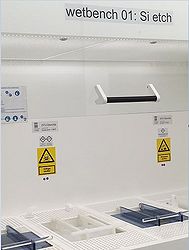Specific Process Knowledge/Etch/KOH Etch
Feedback to this page: click here
Si etch - Anisotropic silicon etch
KOH belongs to the family of anisotropic Si-etchants based on aqueous alkaline solutions. The anisotropy stems from the different etch rates in different crystal directions. The {111}-planes are almost inert whereas the etch rates of e.g. {100}- and {110}-planes are several orders of magnitude faster.
KOH-etching is a highly versatile and cheap way to realize micro mechanical structures if you can live with the necessary Si3N4- or SiO2-masking materials and the potassium contamination of the surface. The latter necessitates in most cases a wet post-clean ('7-up' or RCA-clean) if the wafer is to be processed further.
At DTU Nanolab we use as a standard a 28 wt% KOH. The etch rate - and the selectivity towards a SiO2-mask - is depending on the temperature. We normally use T=80 oC but may choose to reduce this to e.g. 60 oC or 70 oC in case of a high-precision timed etch (e.g. defining a thin membrane). In some cases we recommend to saturate the standard 28 wt% KOH with IPA with an etch temperature at T=70 oC (reduce evaporation of IPA). One example is for boron etch-stop, where the selectivity towards the boron-doped silicon is improved compared to the standard etch. Etching with IPA added to the KOH solution (250ml IPA/1000ml KOH) can be done in KOH fumehood.
- Different places to do anisotropic wet silicon etch
-
Wetbench 01: Si etch, for Si etch of 4" and 6" wafers using KOH. Positioned in cleanroom D-3.
-
Fume hood 06: Si etch, for Si etch of 4" and 6" wafers using KOH. Positioned in cleanroom D-3. This is used for wafers that are considered dirty.
The user manuals, quality control procedures and results, user APVs, technical information and contact information can be found in LabManager:
Si Etch 1: KOH info page in LabManager,
Si Etch 2: KOH info page in LabManager,
Si Etch 3: KOH info page in LabManager
Process Information
KOH etching baths
Key facts for the different etch baths available at Danchip are resumed in the table:
| Equipment | Si Etch 01: KOH | Si Etch 02: KOH | Si Etch 03: KOH | |
|---|---|---|---|---|
| Purpose |
|
|
|
The bath is dedicated wafer with electroplated Nickel or otherwise dirty wafers |
| Link to safety APV and KBA | ||||
| Performance | Etch rates in crystalline silicon (100) |
|
|
|
| Etch rates in crystalline silicon (110) |
|
|
| |
| Etch rates in Thermal SiO2 |
|
|
| |
| Etch rates in other oxides |
. |
yannickseis@nbi.ku nov. 2017 @80 °C:
jemafh@nilt 2019-Marts:
|
. | |
| Etch rates in SiN | ||||
| Roughness |
|
|
| |
| Anisotropy |
|
|
| |
| Process parameter range | Chemical solution |
KOH:H2O - 500 g : 1000 ml, when using pills KOH:H2O - 1000 ml: 1200 ml, when using premixed 50% KOH solution |
KOH:H2O - 500 g : 1000 ml, when using pills KOH:H2O - 1000 ml: 1200 ml, when using premixed 50% KOH solution |
|
| Temperature |
|
|
| |
| Substrates | Batch size |
|
|
|
| Size of substrate |
|
|
| |
| Allowed materials |
|
|
| |
| Masking material |
|
|
| |
1 Measured by Eric Jensen from DTU-Nanotech, October 2013.


